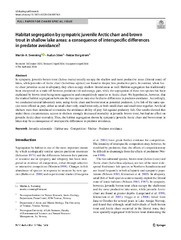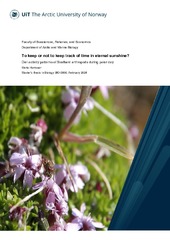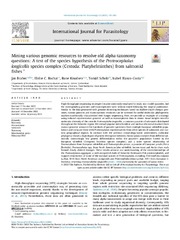Institutt for arktisk og marin biologi: Nye registreringer
Viser treff 201-220 av 2086
-
The impact of advection on a Subarctic fjord food web dominated by the copepod Calanus finmarchicus
(Journal article; Tidsskriftartikkel; Peer reviewed, 2024-05-04)Fjord and shelf food webs are frequently supplemented by the advection of external biomass, which in high-latitude seas often comes in the form of lipid-rich copepods that can support a wide range of fish species, including Northeast Arctic cod (Gadus morhua). A seasonal match or mismatch at the lower trophic levels (phytoplankton and zooplankton) is central in determining how much energy and biomass ... -
Habitat segregation by sympatric juvenile Arctic charr and brown trout in shallow lake areas: a consequence of interspecifc diferences in predator avoidance?
(Journal article; Tidsskriftartikkel; Peer reviewed, 2024-05-06)In sympatry, juvenile brown trout (Salmo trutta) usually occupy the shallow and most productive areas (littoral zone) of lakes, while juveniles of Arctic charr (Salvelinus alpinus) are found in deeper, less productive parts. In contrast, when Arctic charr juveniles occur in allopatry, they often occupy shallow littoral areas as well. Habitat segregation has traditionally been interpreted as a trade-of ... -
Is the diet cyclic phase-dependent in boreal vole populations?
(Journal article; Tidsskriftartikkel; Peer reviewed, 2024-04-17)Herbivorous rodents in boreal, alpine and arctic ecosystems are renowned for their multi-annual population cycles. Researchers have hypothesised that these cycles may result from herbivore–plant interactions in various ways. For instance, if the biomass of preferred food plants is reduced after a peak phase of a cycle, rodent diets can be expected to become dominated by less preferred food plants, ... -
Synchronous timing of return to breedingsites in a long-distance migratory seabirdwith ocean-scale variation in migrationschedules
(Journal article; Tidsskriftartikkel; Peer reviewed, 2024-03-22)Background Migratory birds generally have tightly scheduled annual cycles, in which delays can have carry-over effects on the timing of later events, ultimately impacting reproductive output. Whether temporal carry-over effects are more pronounced among migrations over larger distances, with tighter schedules, is a largely unexplored question. <p><p>Methods We tracked individual Arctic Skuas ... -
Sluttrapport for prosjekt: "Kartlegging og testing av metoder for å redusere interaksjoner mellom fiskeri og hval" - FHF 901681
(Research report; Forskningsrapport, 2024-04-03)Spekkhoggere og knølhval i norske farvann følger den pelagiske fiskeflåten og beiter på fisken som blir samlet sammen av nøtene. Disse interaksjonene har ved flere anledninger ført til skade eller død av hval, og fangsttap og ødelagte redskap for fiskerne. Målsetningen i dette prosjektet var å kartlegge og teste utstyr og metoder som kan bidra til å redusere uønskede interaksjoner mellom spekkhoggere ... -
Reindeer in the Arctic reduce sleep need during rumination
(Journal article; Tidsskriftartikkel, 2023-12-22)Timing and quantity of sleep depend on a circadian (ca 24-h) rhythm and a specific sleep requirement. Sleep curtailment results in a homeostatic rebound of more and deeper sleep, the latter reflected in increased electroencephalographic (EEG) slow-wave activity (SWA) during non-rapid eye movement (NREM) sleep. Circadian rhythms are synchronized by the light-dark cycle but persist under constant ... -
Interannual differences in sea ice regime in the north-western Barents Sea cause major changes in summer pelagic production and export mechanisms
(Journal article; Tidsskriftartikkel; Peer reviewed, 2023-11-22)The Barents Sea is a highly dynamic and productive marine ecosystem and a hotspot of global warming. Variability in sea ice extent is a common feature in the Barents Sea with substantial movements of the sea ice edge on short-term, seasonal to interannual time scales. Historically the northern Barents Sea (north of 75◦N) has been ice-covered in winter, but recently it has become the area with most ... -
Can plastic related chemicals be indicators of plastic ingestion in an Arctic seabird?
(Journal article; Tidsskriftartikkel; Peer reviewed, 2024-03-22)For decades, the northern fulmar (Fulmarus glacialis) has been found to ingest and accumulate high loads of plastic due to its feeding ecology and digestive tract morphology. Plastic ingestion can lead to both physical and toxicological effects as ingested plastics can be a pathway for hazardous chemicals into seabirds' tissues. Many of these contaminants are ubiquitous in the environment and the ... -
Diel activity rhythms in wild songbirds in the Subarctic
(Master thesis; Mastergradsoppgave, 2024-02-15)The highly rhythmic environment caused by the rotation of the earth has driven the evolution of an intrinsic timekeeping mechanism in most organisms known as circadian clocks. As climate change drives the expansion of southern species into northern latitudes, their circadian clocks are challenged by the novel light conditions they encounter. In contrast to the clear day and night in southern latitudes, ... -
To keep or not to keep track of time in eternal sunshine? Diel activity patterns of Svalbard arthropods during polar day
(Master thesis; Mastergradsoppgave, 2024-02-16)Organisms on Earth are exposed to cyclic changes in environmental variables due to Earth’s rotation around it’s axis. As a response, many organisms adapt their behaviour in a rhythmic manner, which is often cued by 24h light-dark cycles. However, in the Arctic, traditional 24h light- dark cycle cues do not exist for long periods at the time. Arthropods play an important role in the high latitude ... -
Long-term warming-induced trophic downgrading in the soil microbial food web
(Journal article; Tidsskriftartikkel; Peer reviewed, 2023-05-01)Climatic warming has been hypothesized to accelerate organic matter decomposition by soil microorganisms and thereby enhance carbon (C) release to the atmosphere. However, the long-term consequences of soil warming on belowground biota interactions are poorly understood. Here we investigate how geothermal warming by 6 °C for more than 50 years affects soil microbiota. Using metatranscriptomics we ... -
Norwegian killer whale movements reflect their different preytypes
(Journal article; Tidsskriftartikkel; Peer reviewed, 2024-03-21)Norwegian killer whales (Orcinus orca) are thought to be generalists that feed primarily on fish, but some individuals have been observed targeting pinnipeds. In the study reported here, field observations of foraging behaviours formed the basis of a priori classification as either seal-eaters or fish-eaters. Concurrent collection of photographic identification and biopsies for stable isotope analysis ... -
Establishment of killer whale cell cultures and their responses to pollutant exposure
(Master thesis; Mastergradsoppgave, 2022-03-15)The cosmopolitan apex predator killer whale (Orcinus orca) is one of the species worldwide with the highest levels of persistent organic pollutants (POPs) in their tissues. The knowledge of how POPs may affect the species is limited, likely due to the ethical, legal, and practical challenges of researching toxicology on free-ranging marine mammals. The use of in vitro models has proved to be a ... -
Bioglider: an integrated glider solution for enhancing environmental knowledge
(Journal article; Tidsskriftartikkel; Peer reviewed, 2023-12-11)This paper presents a technological solution for the observation and monitoring of the marine ecosystem. Three complementary devices, one optic imaging and one scientific acoustic instrument as well as one acoustic communication modem, have been integrated on glider platforms, providing qualitative and quantitative zooplankton and fish ecology observations, which are especially relevant in Nordic ... -
Mining various genomic resources to resolve old alpha-taxonomy questions: A test of the species hypothesis of the Proteocephalus longicollis species complex (Cestoda: Platyhelminthes) from salmonid fishes
(Journal article; Tidsskriftartikkel; Peer reviewed, 2023-01-24)High-throughput sequencing strategies became commonly employed to study non-model parasites, but the corresponding genomes and transcriptomes were seldom mined following the original publication. Similar to the data generated with genome skimming techniques based on shallow-depth shotgun gen omes, various genomic and transcriptomic resources can be screened for useful molecular phylogenetic markers ... -
Comparative analysis of the cytoarchitecture of the excretory bladder of adult Digenea (Platyhelminthes) with consideration of the presence of mineralized excretory corpuscles in marine and freshwater adult worms
(Journal article; Tidsskriftartikkel; Peer reviewed, 2024-02-01)The ultrastructural differences are shown between the cytoarchitecture of the excretory bladder and excretory inclusions in four digenean species, two azygiids, the marine Otodistomum cestoides and the freshwater Azygia lucii, the marine derogenid Derogenes varicus and the freshwater allocreadiid Acrolichanus auriculatus. The unusual cytoarchitecture of the bladder epithelium of the azygiid digeneans, ... -
Biological timekeeping in polar environments: lessons from terrestrial vertebrates
(Journal article; Tidsskriftartikkel; Peer reviewed, 2023-11-30)The polar regions receive less solar energy than anywhere else on Earth, with the greatest year-round variation in daily light exposure; this produces highly seasonal environments, with short summers and long, cold winters. Polar environments are also characterised by a reduced daily amplitude of solar illumination. This is obvious around the solstices, when the Sun remains continuously above (polar ... -
Quantifying zoobenthic blue carbon storage across habitats within the Arctic’s Barents Sea
(Journal article; Tidsskriftartikkel; Peer reviewed, 2024-01-26)Introduction: The Arctic sea ice extent in September (when it is at its lowest) has declined 13% Q10 per decade, and the Arctic Ocean is becoming a more Atlantic-influenced system. Rapid climate-forced changes are taking place in many high-latitude marine ecosystems. The Barents Sea is one such highlatitude shelf ecosystem, between approximately 70° and 80°N in the Norwegian Arctic. The purpose ... -
Grazing intensity drives a trophic shift in the diet of common alpine birds
(Journal article; Tidsskriftartikkel; Peer reviewed, 2023-02-18)Large mammalian herbivores (LMH) shape vertebrate communities and structure food webs in many terrestrial ecosystems. However, the mechanisms that underlie the effects of LMH on other vertebrates are poorly understood. In France, domestic LMH have grazed alpine and mountain grasslands for thousands of years, profoundly influencing landscapes and wildlife. As LMH modify habitat structure, favour ... -
What Is the Impact of Accidentally Transporting Terrestrial Alien Species? A New Life Cycle Impact Assessment Model
(Journal article; Tidsskriftartikkel; Peer reviewed, 2024-02-08)Alien species form one of the main threats to global biodiversity. Although Life Cycle Assessment attempts to holistically assess environmental impacts of products and services across value chains, ecological impacts of the introduction of alien species are so far not assessed in Life Cycle Impact Assessment. Here, we developed country-to-country-specific characterization factors, expressed as the ...


 English
English norsk
norsk


















